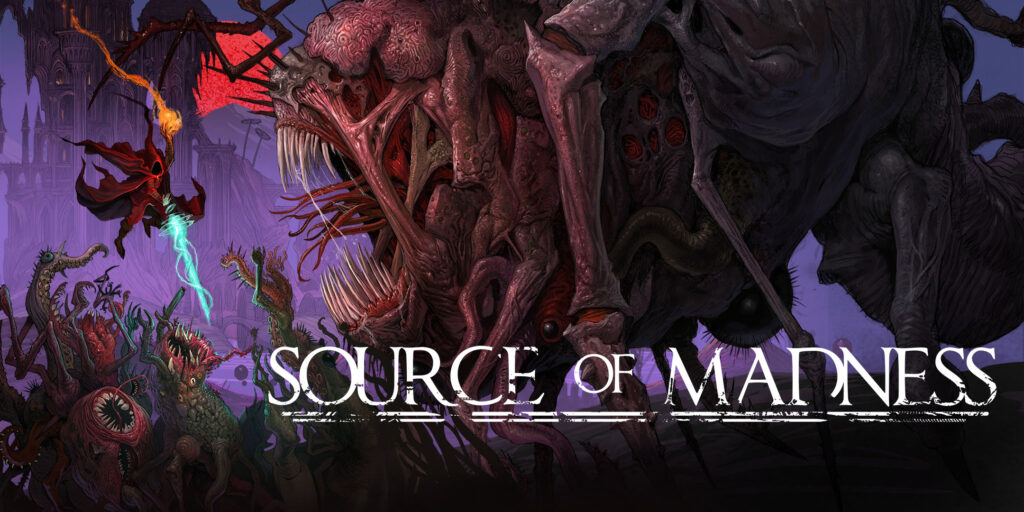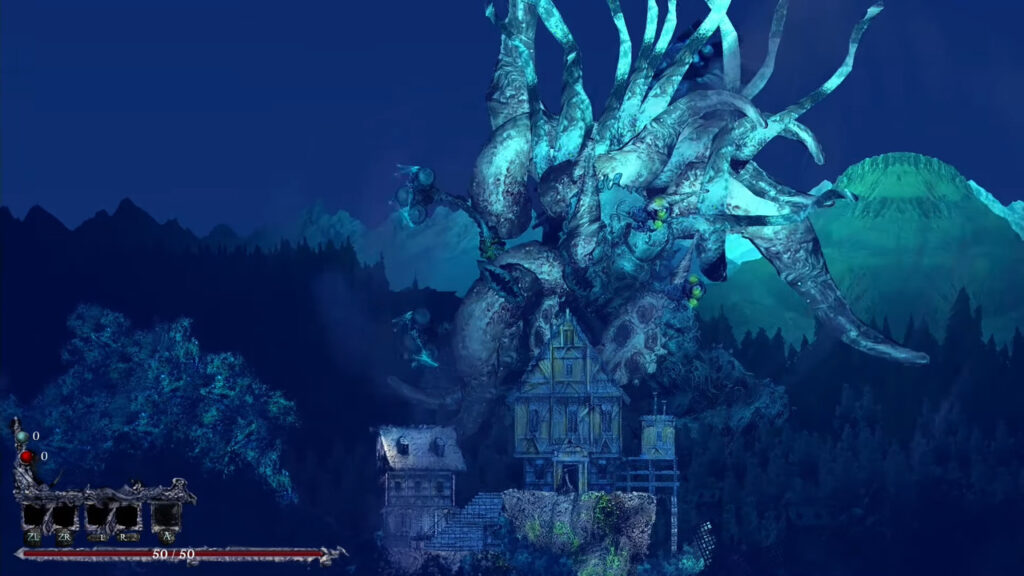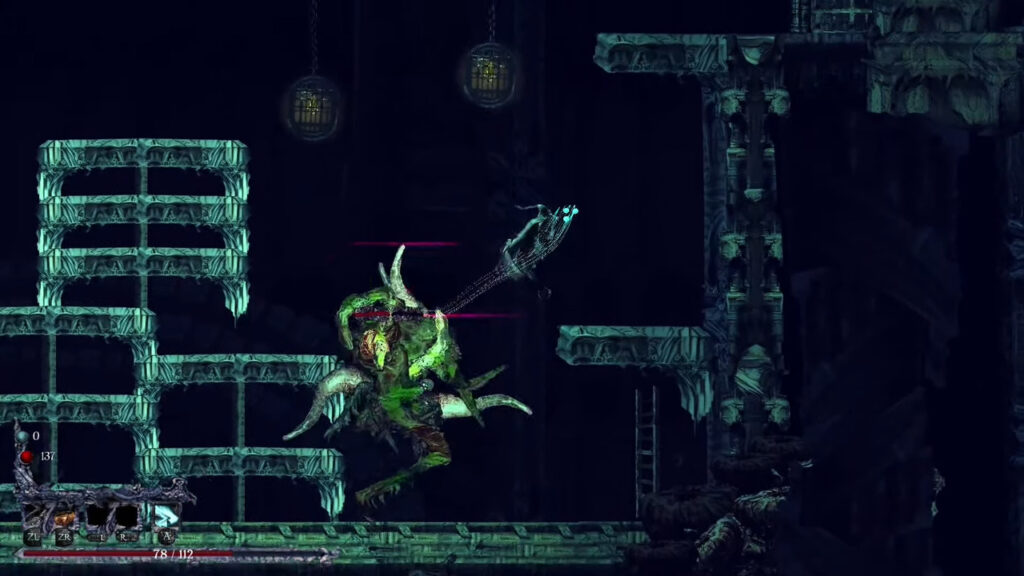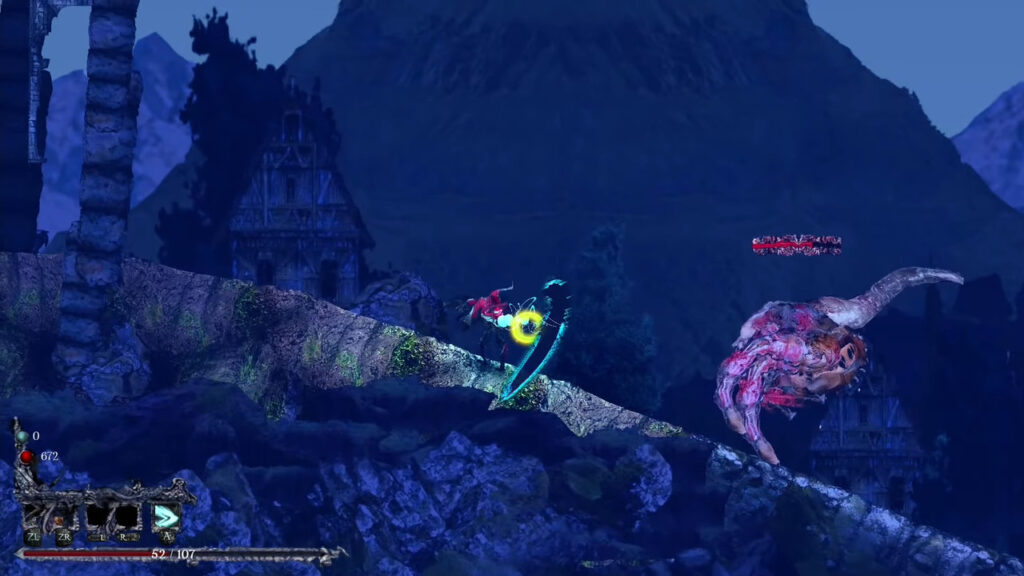
Developer: Carry Castle
Publisher: Thunderful Games
Platform: Switch, PS4, PS5, Xbox One, Xbox Series X|S, PC
Tested on: Switch
Source of Madness – Review
H.P. Lovecraft’s writings remain a source of inspiration for video game developers. Last year, we took a look at no less than seven games that either were directly based on his stories, or at least took inspiration from them. 2022 is also shaping up to be a good year for gamers that are fans of the renowned horror author, with both Lovecraft’s Untold Stories 2 and Source of Madness having released last month. Given that we hadn’t reviewed a Lovecraft-inspired game yet this year, we were well overdue to do so, and as such we’re taking a look at Source of Madness today. Will developer Carry Castle’s roguelike sidescroller scratch our Lovecraftian itch or will it destroy our sanity?
Story
While Source of Madness takes inspiration from the stories of H.P. Lovecraft, there isn’t a real story present here in the traditional sense. Yes, there are occasional cutscenes, and hints at larger events, but they never come to fruition. The story is kept deliberately vague and we never even learn about the identity or motivation of the cultist protagonist (or protagonists, as you’ll find out in the gameplay section). Instead, it seems like whatever narrative clues are present here are intended to be easter eggs for anyone familiar with the Lovecraftian Mythos. The game relies on the player to fill in the blanks, and while this certainly feels fitting for the spirit of Lovecraft, we much preferred the approach taken by other games inspired by the setting, like Conarium or The Innsmouth Case.
Graphics
With a beautiful art style and gorgeous lighting effects, Source of Madness’ visuals certainly don’t disappoint. The game’s art style felt reminiscent of classic paintings at times, which felt very fitting, and at other times, it resembled a twisted version of Gris. Aesthetically, Source of Madness’ visuals are the game’s highlight, though performance-wise, we noticed stuttering and frame drops more often than we would like. The screenshots don’t really do the game justice, as it looks a lot better in motion, as evidenced by the trailer.
Sound
We recommend playing this title with headphones, as the game’s soundscape becomes a lot more impressive when you’re able to immerse yourself in it fully. The sound effects utilized here are fantastic, both the screams made by enemy monsters and the noises related to weapons and spells. There is also limited narration during the opening scene, with a surprisingly convincing performance. The deep voice declaring doom and gloom often feels over the top and cheesy, but it works really well here. The one gripe we had with the soundscape was that the music was overshadowed by the other sound effects, but this was something that could be manually adjusted in the game’s settings. So, after a bit of tweaking, we were good to go.
Gameplay
At first glance, Source of Madness looks like just another side-scrolling roguelike shooter, something we’ve seen dozens of times before. However, the game boasts a couple of features that should make it feel unique, at least in theory. The main gimmick here is that the enemies that you encounter are procedurally generated. This ties into the Lovecraftian setting of the game, as the author often wrote about horrors whose physical appearance could not be described in human words, and looking at them would be enough to drive someone insane. While the creatures appearing in Source of Madness won’t affect the sanity of its players, the misshapen lumps of flesh and tentacles do look suitably gruesome and disgusting. Source of Madness’ secondary standout feature is that the game uses machine learning to tailor the behavior of its procedurally generated enemies to your specific playstyle.
These two features ensure that no two runs of Source of Madness play out in the same way. A run starts out in a cathedral, where you’ll find a portal that takes you into a different reality, a horrifying world inhabited by the aforementioned nightmarish creatures. You’ll need to survive as long as possible of course, and better results mean better rewards. Once you meet your untimely demise at the hands (or tentacles) of one of the monsters, a new character will get its chance for survival. There are different classes available, as well as abilities and upgrades that you purchase with in-game currency, so subsequent characters get better. You’d expect the game to become easier over time then, as you get stronger with each run, but as we mentioned before, the game’s enemy AI adapts to your playstyle, and so Source of Madness remains a brutal game throughout.
Despite the two main features sounding great in theory, they suffer when it comes to execution. Because the game adapts to your playstyle, and not the other way round, there is no real sense of growth and no strategic thinking involved, especially during the first few hours. The best early game strategy seems to be to simply spam ranged magical attacks as you don’t know the attack patterns of enemies, and as such you never learn to really deal with anything in a different way. Add to this that the tutorial doesn’t fully explain everything, and you’re left to your own devices to figure out how everything works. Due to this, you’d best prepare yourself for a rough few opening hours. It’s a shame because there is plenty of potential here, with the wide range of spells -which can be combined- but the game never incentivizes you to try out something different. Instead, it feels like it continuously wants to punish you for experimenting, which felt strange in a game built around adaptive AI.
Gradually, new equipment is unlocked -such as after a boss fight- and new options to take down enemies become available, but it feels too little too late, especially when keeping in mind just how much certain abilities and upgrades cost to purchase. By the time you’ve unlocked a new toy to play with, chances are you’re already bored with Source of Madness in the first place. The procedurally-generated enemies all look different, but they feel similar, making for a repetitive game despite the theoretical infinite replayability. It seems like Source of Madness is a bit ahead of its time with its main idea, as the technology behind procedurally generated enemies and adaptive AI can’t quite catch up with what the game should do in theory.
It adds up to a fairly unremarkable roguelike game that doesn’t do enough to keep players entertained for more than a few hours. To make matters worse, the Switch version of the game struggles when it comes to performance. We can’t speak for other platforms, but whenever there are more than a handful of enemies on screen at the same time, the Switch version becomes a stutterfest. Aiming your spells becomes a guessing game and carefully timed shots are no longer a certainty. Hopefully, this is something that can be resolved with an update or two, but as it stands, the Switch version is best avoided. As for the other versions, we can’t imagine that an improved performance solves Source of Madness’ other issues, so unless you’re a diehard fan of Lovecraft or are simply looking for a punishing roguelike and don’t mind the lack of variety, you’re better off avoiding the game altogether. That said, our score for the game does reflect the Switch version so if the aforementioned performance issue doesn’t persist on the other platforms, you can add another point to the final score.
Conclusion
We absolutely adored the ideas behind Source of Madness so the end result felt like a major letdown. Aesthetically, we can’t quite fault the game, although the story could use some more fleshing out, but the performance issues on Switch combined with repetitive gameplay and disappointing adaptive AI made for a game that is difficult to recommend. The potential certainly is there in theory, and perhaps in a couple of years Carry Castle will release a game that fully allows their ideas to shine.
Source of Madness - Review,









No Comments